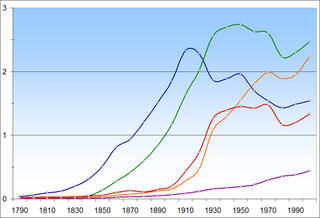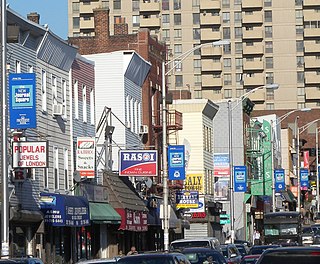Dougla people are Caribbean people who are of mixed African and Indian descent. The word Dougla is used throughout the Dutch and English-speaking Caribbean.

Richmond Hill is a commercial and residential neighborhood located in the southeastern section of the New York City borough of Queens. The area borders Kew Gardens and Forest Park to the north, Jamaica and South Jamaica to the east, South Ozone Park to the south, and Woodhaven and Ozone Park to the west. The neighborhood is split between Queens Community Board 9 and 10.

New York City is a large and ethnically diverse metropolis. It is the largest city in the United States with a long history of international immigration. The New York region continues to be by far the leading metropolitan gateway for legal immigrants admitted into the United States. The city is the geographical and demographic center of both the Northeast megalopolis and the New York metropolitan area, the largest metropolitan area in the U.S. by both population and urban area. With over 20.1 million people in its metropolitan statistical area and 23.5 million in its combined statistical area as of 2020, New York City is one of the world's most populous megacities.
Indo-Guyanese or Indian-Guyanese, are Guyanese nationals of Indian origin who trace their ancestry to India and the wider subcontinent. They are the descendants of indentured servants and settlers who migrated from India beginning in 1838, and continuing during the British Raj.
Indo-Caribbean Americans or Indian-Caribbean Americans, are Americans who trace their ancestry ultimately to India, though whose recent ancestors lived in the Caribbean, where they migrated beginning in 1838 as indentured laborers. There are large populations of Indo-Trinidadian and Tobagonians and Indo-Guyanese along with a smaller population of Indo-Surinamese, Indo-Jamaicans and other Indo-Caribbeans in the United States, especially in the New York metropolitan area and Florida. The Washington metropolitan area, Texas, and Minnesota also have small numbers of Indo-Guyanese and Indo-Trinidadians. Indo-Caribbean Americans are a subgroup of Caribbean Americans as well as Indian Americans, which are a subgroup of South Asian Americans, which itself is a subgroup of Asian Americans.
Laura Cordelia Creavalle is a Guyanese-born Canadian/American professional female bodybuilder.

The demographics of Queens, the second-most populous borough in New York City, are highly diverse. No racial or ethnic group holds a majority in the borough.

Caribbean Americans or West Indian Americans are Americans who trace their ancestry to the Caribbean. Caribbean Americans are a multi-ethnic and multi-racial group that trace their ancestry further in time mostly to Africa, as well as Asia, the Indigenous peoples of the Americas, and to Europe. As of 2016, about 13 million — about 4% of the total U.S. population — have Caribbean ancestry.

Since its founding in 1625 by Dutch traders as New Amsterdam, New York City has been a major destination for immigrants of many nationalities who have formed ethnic enclaves, neighborhoods dominated by one ethnicity. Freed African American slaves also moved to New York City in the Great Migration and the later Second Great Migration and formed ethnic enclaves. These neighborhoods are set apart from the main city by differences such as food, goods for sale, or even language. Ethnic enclaves provide inhabitants security in work and social opportunities, but limit economic opportunities, do not encourage the development of English speaking, and keep immigrants in their own culture.
Trinidadian and Tobagonian Americans are people with Trinidadian and Tobagonian ancestry or immigrants who were born in Trinidad and Tobago. Trinidad and Tobago is home to people of many different national, ethnic and religious origins. As a result, people of Trinidadian and Tobagonian descent do not equate their nationality with ethnicity. The largest proportion of Trinidadians lives in the New York metropolitan area, with other large communities located in South Florida, Central Florida, Pennsylvania, Maryland, Texas, Minnesota, Georgia, and Massachusetts. There are more than 223,639 Trinbagonian Americans living in the United States.
Citizens or residents of the United Kingdom whose origins lie in Guyana are a part of the country's British Caribbean community. Guyana was a former British colony, British Guiana, responsible for moving large numbers of Africans and Indians for labour in the sugar industry. British Guyanese are notable for their contributions to literature and music.

The people of Guyana, or Guyanese, come from a wide array of backgrounds and cultures including aboriginal natives, African and Indian origins, as well as a minority of Chinese and European descendant peoples. Demographics as of 2012 are Indo-Guyanese 39.8%, Afro-Guyanese 30.1%, mixed race 19.9%, Amerindian 10.5%, other 1.5%. As a result, Guyanese do not equate their nationality with race and ethnicity, but with citizenship. Although citizens make up the majority of Guyanese, there is a substantial number of Guyanese expatriates, dual citizens and descendants living worldwide, chiefly elsewhere in the Anglosphere.

Overseas Indians, officially Non-Resident Indians (NRIs) and People of Indian Origin (PIOs) are Indians who reside or originate outside of India. According to the Government of India, Non-Resident Indians are citizens of India who currently are not living in India, while the term People of Indian Origin refers to people of Indian birth or ancestry who are citizens of countries other than India. Overseas Citizenship of India (OCI) is given to People of Indian Origin and to persons who are not People of Indian Origin but married to People of Indian Origin. Persons with OCI status are known as Overseas Citizens of India (OCIs). The OCI status is a permanent visa for visiting India with a foreign passport.

Liberty Avenue is an 8-mile (13 km) long west-east avenue in Brooklyn and Queens, New York City. It is bidirectional for most of its length, running between Mother Gaston Boulevard in Brooklyn in the west and Farmers Boulevard in Queens in the east.

Women in Guyana are a cross-section of Asian, African, and indigenous backgrounds. British colonization and imperialism have contributed to the sexism against Guyanese women in the household, politics, and education.
Persaud is a Hindu surname primarily found in the Caribbean, especially Guyana and Trinidad & Tobago. It is derived from the Hindi surname प्रसाद which is predominantly transliterated as Prasad in India. Other variant forms include Persad, Persard, Pershad, Prasada, Prashad, Presad, and Presaud.

Indians in the New York City metropolitan area constitute one of the largest and fastest-growing ethnicities in the New York City metropolitan area of the United States. The New York City region is home to the largest and most prominent Indian American population among metropolitan areas by a significant margin, enumerating 711,174 uniracial individuals based on the 2013–2017 U.S. Census American Community Survey estimates. The Asian Indian population also represents the second-largest metropolitan Asian national diaspora both outside of Asia and within the New York City metropolitan area, following the also rapidly growing and hemisphere-leading population of the estimated 893,697 uniracial Chinese in the New York City metropolitan area in 2017.
The city of Baltimore, Maryland includes a large and growing Caribbean-American population. The Caribbean-American community is centered in West Baltimore. The largest non-Hispanic Caribbean populations in Baltimore are Jamaicans, Trinidadians and Tobagonians, and Haitians. Baltimore also has significant Hispanic populations from the Spanish West Indies, particularly Puerto Ricans, Dominicans, and Cubans. Northwest Baltimore is the center of the West Indian population of Baltimore, while Caribbean Hispanics in the city tend to live among other Latinos in neighborhoods such as Greektown, Upper Fell's Point, and Highlandtown. Jamaicans and Trinidadians are the first and second largest West Indian groups in the city, respectively. The neighborhoods of Park Heights and Pimlico in northwest Baltimore are home to large West Indian populations, particularly Jamaican-Americans.
As according to the New York City Department of City Planning, there were a total of 8,804,190 residents. There were almost equivalent populations of 2,719,856 White residents at 30.9% and 2,490,350 Hispanic residents at 28.3%, meanwhile there were 1,776,891 Black residents at 20.2% and 1,373,502 Asian residents at 15.6%. There were even much smaller numbers of 143,632 other race residents at 1.6% and 299,959 Two or More races residents at 3.4%. The White population declined mainly in Queens, The Bronx, and then Staten Island, though the White population increased marginally in Brooklyn and then Manhattan. The Black population experienced declines by Brooklyn, Queens, and Manhattan, increasing marginally in the Bronx and Staten Island. The Hispanic population increased in the Bronx, Queens, Brooklyn, and Staten Island, but experienced decline in Manhattan. The Asian population increased in all five boroughs.









